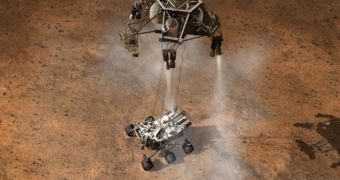With less than 9 days to go until the Mars Science Laboratory (MSL) rover Curiosity lands on the Red Planet, scientists at the American space agency are scrambling to check and double-check the systems that will enable them to monitor the $2.5 billion mission.
MSL has been en route to Mars for more than eight months, after launching from the Cape Canaveral Air Force Station (CCAFS), in Florida, on November 26, 2011. It was delivered to Earth's orbit aboard an United Launch Alliance (ULA) Atlas V delivery system.
This mission features the most complex landing sequence ever conducted. The spacecraft will enter the Martian atmosphere at the steepest angle yet, will experience the highest reentry temperatures, will deploy the largest parachutes, will go through 76 pyrotechnic blasts and will use the Sky Crane system.
The latter has never been used before. Basically, what it comes down to is a flying platform (supported by four thrusters) lowering a 1-ton, Mini Cooper-sized rover onto the Martian surface, via a cable.
All the aforementioned stages in the landing process will go on during the so-called 7 Minutes of Terror, when mission controllers at the NASA Jet Propulsion Laboratory (JPL), in Pasadena, California will be unable to communicate with the vehicle.
The situation is made even worse by the fact that Earth will be located beyond the horizon at Gale Crater, where Curiosity will land. Fortunately, NASA and the European Space Agency (ESA) figured out a way to handle this issue.
Over the past few days, all three spacecraft that fly above the Red Planet have been repositioned so that their orbits will take them over Gale Crater as the MSL lands. These vehicles are the Mars Odyssey and Mars Reconnaissance Orbiter (NASA) and the Mars Express (ESA).
During the critical minutes leading up to surface contact, the trio of orbiters will collect data on the descending MSL, and relay them to Earth via the NASA Deep Space Network (DSN) antenna.
“We began optimizing our orbit several months ago, so that Mars Express will have an orbit that is properly “phased” and provides good visibility of MSL’s planned trajectory,” ESA Mars Express spacecraft operations manager, Michel Denis, says.
“NASA supported the arrival of Mars Express at Mars in 2003, and, in the past few years, we have relayed data from the rovers Spirit and Opportunity,” adds the leader of ESA Mission Operations, Manfred Warhaut.
“Technical and scientific cooperation at Mars between ESA and NASA is a long-standing and mutually beneficial activity that helps us both to reduce risk and increase the return of scientific results,” the latter concludes, quoted by Universe Today.

 14 DAY TRIAL //
14 DAY TRIAL //